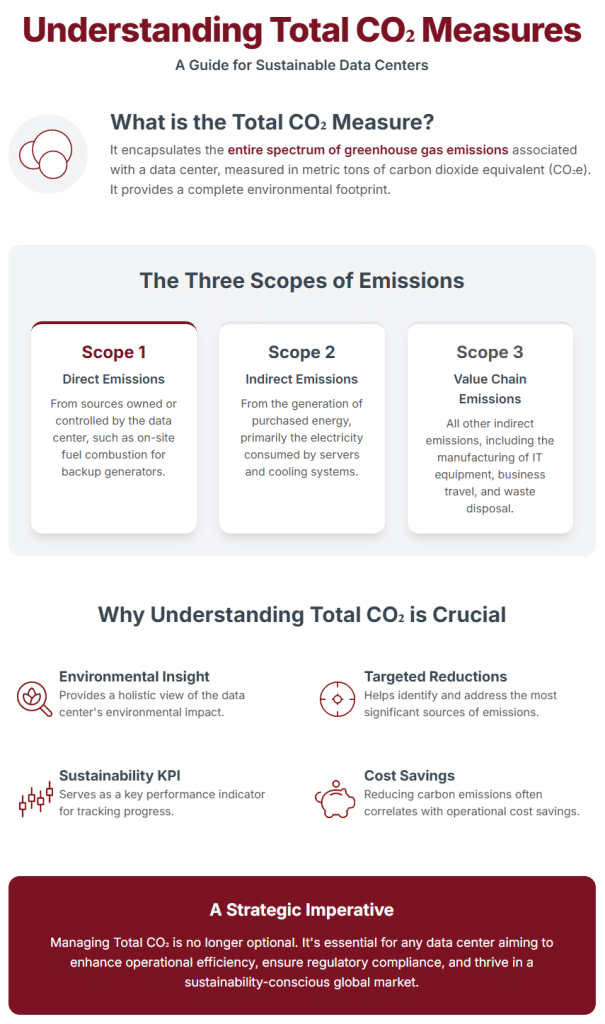The Crucial Role of Understanding Total CO2 Measures in Achieving Sustainable Data Centers
Published on February 20, 2024,
by
Total CO2 in data centers is a critical metric for understanding and reducing environmental impact. By measuring emissions across Scopes 1, 2, and 3, this comprehensive indicator helps operators identify major sources of carbon output and implement targeted sustainability strategies. As pressure mounts from regulators and stakeholders, tracking Total CO2 is essential for achieving carbon neutrality and enhancing operational efficiency.

The Total CO2 measure encapsulates the entire spectrum of emissions associated with a data center, measured in metric tons of carbon dioxide equivalent (CO2e). This includes direct emissions from on-site fuel combustion (Scope 1), indirect emissions from purchased electricity (Scope 2), and other indirect emissions spanning the data center's entire value chain (Scope 3). While Scope 1 and Scope 2 emissions are relatively easier to quantify, Scope 3 emissions pose a significant challenge due to their complexity and the extensive data required for accurate calculation.
Understanding the Total CO2 measure is imperative for several reasons. Primarily, it offers a clear picture of the environmental footprint of data center operations, allowing operators to identify and address the most significant sources of emissions. This insight is crucial for implementing targeted strategies to reduce environmental impact effectively.
Moreover, as the global call for sustainability grows louder, with demands from governments, investors, and the public for greener practices, the Total CO2 measure serves as a vital Key Performance Indicator (KPI) for data centers. Tracking this measure over time enables data centers to demonstrate their commitment to sustainability and their progress toward achieving carbon neutrality.
Furthermore, there is a direct correlation between reducing carbon emissions and operational cost savings. Initiatives aimed at enhancing energy efficiency not only contribute to lower carbon footprints but also lead to significant reductions in energy expenses. This synergy between environmental stewardship and economic benefit underscores the importance of the Total CO2 measure in driving sustainable practices in data center operations.
Calculating the Total CO2 measure involves a detailed analysis of energy consumption and other emission sources within a data center. Scope 1 emissions entails identifying all direct emission sources, such as generators and cooling systems, and calculating the emissions based on fuel consumption and specific emission factors. Scope 2 emissions are determined by the amount of consumed electricity and the emission factor provided by the electricity supplier. Scope 3 emissions, the most complex to assess, require a thorough understanding of the data center's supply chain and the life cycle of its products, often involving lifecycle analysis techniques.
Given the complexity of accurately calculating the Total CO2 measure, data centers can leverage various tools and methodologies developed by organizations such as the World Business Council for Sustainable Development (WBCSD). The Greenhouse Gas Protocol offers comprehensive guidelines and calculators designed to simplify the calculation process while ensuring precision and reliability.
In conclusion, understanding and managing the Total CO2 measure is not just a regulatory or environmental obligation but a strategic imperative for data centers aiming to thrive in a sustainability-conscious market. By embracing this measure, data centers can minimize their environmental impact and enhance their operational efficiency and competitiveness in the global digital landscape.
Additional Resources
White Paper: Fundamental Measures of Data Center Sustainability
Executive Brief: Climate Risk Disclosures in Data Centers - A Review of the Proposed SEC Guidelines
Executive Brief: Singapore's Data Centre Energy Efficiency Scheme (DCS)
The Critical Role of Scope 2 Emissions in Data Center Sustainability Efforts
